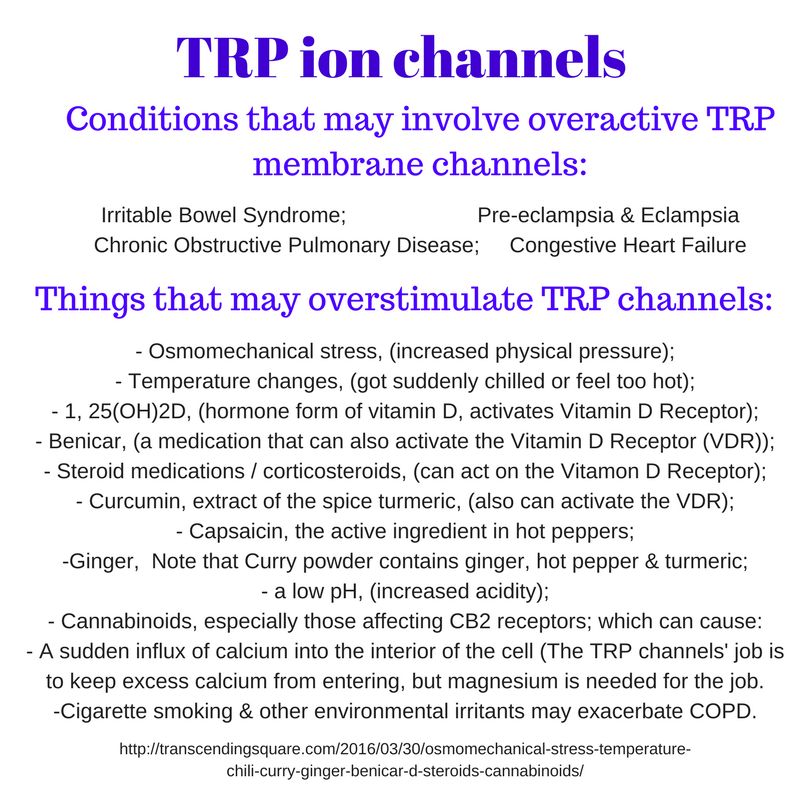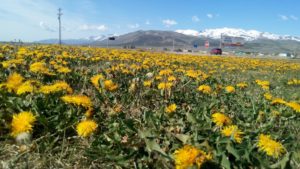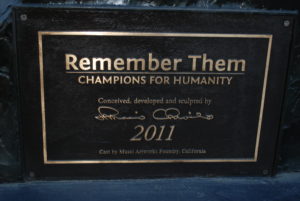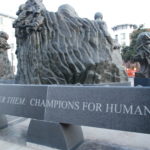“Whenever we see something which could be done to bring benefit to others, no matter how small, then we should do it.” — Tai Situ Rinpoche
(SamyeLing.org)
Sometimes getting started is the hardest part.
Notes & links for TRP channel enthusiasts, on chronic pain, gender differences with migraine, IBS/colitis, and the role of magnesium and TRP channels in fetal development:
The condensed version – women are more prone to migraines then men possibly due to a protective effective of testosterone. Estrogen may increase or decrease risk of migraine depending on amounts/balance with progesterone. Either way, magnesium deficiency can increase chronic pain and other TRP channel problems because it is a mineral that helps keep them closed – they are like gates in the cell membrane.
Magnesium deficiency in very early stages of pregnancy or conception can have a negative impact on development of the embryo which can cause problems with physical and/or brain growth which can affect the infant throughout life. Pumpkin seeds has been the short answer I’ve given for years (post) – they are a good source of magnesium and many other nutrients, about one to two ounces, 2-4 tablespoons per day is a healthy serving. Like many things in life too much regularly may not be as healthy. Epsom salt baths are a topical source of magnesium and sulfate which would bypass any problems with digestion making it a good source for people with Irritable Bowel Syndrome or colitis, both of which can be problems linked to overactive TRP channels. (More about magnesium sources.)
Stress can be a cause of overactive TRP channels in addition to the risk of changes occurring during early conception/embryological development.
Other triggers for TRP channels include hot pepper (capsaicin), vitamin D/ and curcumin (a vitamin D analog) a phytonutrient found in turmeric, the yellow spice used in curry powder, ginger, horseradish; volatile chemicals such as formaldehyde, gasoline fumes, cigarette smoke, ammonia; very cold temperatures or very hot temperatures; increased pressure such as might occur during carnival rides or from overeating a large meal or gassy meals with large servings of raw vegetables such as cabbage or broccoli. Cinnamon, mint, vanilla can also activate some types of TRP channels – there is a large variety of TRP channels and they don’t all react to the same triggers and not all types are found in the same organ systems within the body so migraines and bowel troubles may not share the same triggers, but having a place to start can be helpful instead of feeling that everything you eat or do might be a problem.
Interesting hot pepper trivia: “Although both sexes showed sensitivity to capsaicin, males required a four-fold higher dose of capsaicin than females for a similar response (Lu et al., 2009)” (ref 2)
Quotes from an excerpt of ref 1,
(https://www.researchgate.net/figure/Involvement-of-TRP-channels-in-stress-TRPV1-a-member-of-TRP-channel-is-present-in_fig2_234019431) )
Importance of TRP channels in pain:
- Implications for stress, causal or strong correlation: “altered expression, function and/or regulation of TRPs are key changes which induce patho-physiological conditions like stress, neuropathic pain and cancer.”
- “TRPM2 and TRPV4 are involved in oxidative stress- induced cell death of hippocampal neurons (121).” – the hippocampus is an area involved in short term memory and is damaged early in Alzheimer’s disease.
- “several TRPs can also be activated by estrogen, endrogen, testosterone, cortisol and many other steroids (Table 1)”– so stress could increase TRP channel activity due to inc levels of cortisol. /Speculation: Estrogen mimetics might also be over activating TRP channels./
- Overactivating TRP channels can also cause IBS symptoms: “over-stimulation of TRPs leads to an influx of excess Ca 2+ which is generally associated with the cell death (126)”
- “TRPV1 regulates food absorption, emesis, colitis and also regulates the gut – brain axis mainly by responding to endovanilloids and endocannabinoids (132-133).” – colitis is a more severe bowel condition than IBS, has similarities in symptoms though
Re reference 2:
Migraines are 3 times more likely to be a problem for women than men and it may be due to the sex hormone’s ability to activate TRPV1 channels https://www.ncbi.nlm.nih.gov/pmc/articles/PMC6102492/ … this info may help with developing more targeted treatments.
“migraineur women exhibited a thicker posterior insula and precuneus cortices compared to male migraineurs & the healthy controls of both sexes (Maleki et al., 2012)”
Testosterone may help protect men from migraines or as severe a migraine if they do have one. It helps modulate activity of TRPM8 channels. Over expression of TRPM8 channels “by a testosterone-mediated mechanism” is seen in prostate cancer.
Re reference 3:
Genetic differences in gene for TRPM8 channels (transient receptor potential melastatin 8) have been identified that are more common in people w migraine sensitivity. They are activated by cold temperatures and/or menthol (mint).
Re reference 4:
TRPM6 & TRPM7 channels and magnesium are known to be critical in embryological development, inc pigmentation/melanin. Mg deficiency during pregnancy can cause significant problems.
TRPM7 & magnesium also critical for dopaminergic cells/Parkinson’s disease. other embryo dev differences w Mg deficiency were seen in the gut & spine (less straight). – a review: TRPM Channels and Magnesium in Early Embryonic Development (4)
TRP channels may become overly active from stress or during fetal development. The symptoms can be difficult to notice a pattern of triggers because the TRP channels have many different ways of being activated. See the G3 excerpt in this document for more details, Child Trauma, Possible Relationship or Chronic Physical Symptoms as an Adult – or for a more condensed version see the graphic below.
(QuoteInvestigator)
“If I had more time, I would have written a shorter letter.” ~ Blaise Pascal

“Well begun is half done.” – Aristotle
Disclaimer: This information is provided for educational purposes within the guidelines of fair use. It is not intended to provide individual health care guidance. Please seek a health care professional for individualized health care guidance.
References:
- Kumar, Ashutosh & Goswami, Luna & Goswami, Chandan. (2013). Importance of TRP channels in pain: Implications for stress. Frontiers in bioscience (Scholar edition). S5. 19-38. https://www.researchgate.net/publication/234019431_Importance_of_TRP_channels_in_pain_Implications_for_stress
- Artero-Morales M, González-Rodríguez S, Ferrer-Montiel A. TRP Channels as Potential Targets for Sex-Related Differences in Migraine Pain. Front Mol Biosci. 2018;5:73. Published 2018 Aug 14. https://www.ncbi.nlm.nih.gov/pmc/articles/PMC6102492/doi:10.3389/fmolb.2018.00073 Interesting hot pepper trivia: “Although both sexes showed sensitivity to capsaicin, males required a four-fold higher dose of capsaicin than females for a similar response (Lu et al., 2009)”
- Dussor G, Cao YQ. TRPM8 and Migraine. Headache. 2016;56(9):1406-1417. https://www.ncbi.nlm.nih.gov/pmc/articles/PMC5335856/
- Komiya Y, Runnels LW. TRPM channels and magnesium in early embryonic development. Int J Dev Biol. 2015;59(7-9):281-8. https://www.ncbi.nlm.nih.gov/pmc/articles/PMC4685952/



































































